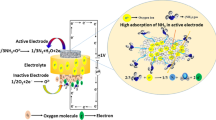Abstract
A mixed-potential, electrochemical sensor platform is extended to NH3 sensing by the introduction of a new gold alloy working electrode. A planar, pre-commercial NH3 sensor utilized LANL’s controlled interface approach, and a Pd-Au alloy working electrode was tested in exhaust of a GM 1.9 L diesel engine downstream of a diesel oxidation catalyst through a slipstream arrangement. A fraction of the exhaust was pulled across the sensor with a pump at 20 L/min. In order to simulate NH3 slip inside of a full SCR emissions control system, NH3 was injected immediately upstream of the sensor using a calibrated mass flow controller. The sensor response quantitatively tracked the NH3 as measured via Fourier transform infrared (FTIR) analyzer. A calibration curve was obtained in the exhaust from an ammonia staircase response with the engine running at steady-state engine conditions resulting in low background concentrations of NOx and HC (<20 ppm) during calibration. Exhaust gas recirculation (EGR) switching and sweeps were used to evaluate the NH3 sensor response under different amounts of total background NOx. The calibration curve was used to directly compare the [NH3] calculated from sensor response to the gas phase composition measured via FTIR. In general, there was excellent quantitative agreement between the sensor response and the actual NH3 in the exhaust gas, and fast response time such that transients (<5 ppm) could be easily discerned from baseline. A LANL pre-commercial NOx sensor was tested simultaneously with the NH3 sensor and the extent of cross-sensitivity between the two sensors will be discussed.













Similar content being viewed by others
References
U.S. Environmental Protection Agency: 2017 and Later Model Year Light-Duty Vehicle Greenhouse Gas Emissions and Corporate Average Fuel Economy Standards; Final Rule, Department of Transportation, National Highway Traffic Safety Administration, 77,199 (2012), 62623–63200.
Twigg, M.V.: Progress and future challenges in controlling automotive exhaust gas emissions. Appl Catal B Environ 70, 2–15 (2007)
U.S. Environmental Protection Agency: Control of Air Pollution From Motor Vehicles: Tier 3 Motor Vehicle Emission and Fuel Standards; Final Rule, Environmental Protection Agency, 79,81 (2014).
Stanton, D.: Systematic development of highly efficient and clean engines to meet future commercial vehicle greenhouse gas regulations. SAE Int J Engines 6, 1395–1480 (2013)
Fergus, J.W.: Sensing mechanism of non-equilibrium solid-electrolyte-based chemical sensors. J. Solid State Electrochem. 15(5), 971–984 (2010)
Garzon, F.H., Mukundan, R., Brosha, E.L.: Solid-state mixed potential gas sensors: theory, experiments and challenges. Solid State Ion. 136–137, 633–638 (2000)
Mukundan, R., Brosha, E.L., Garzon F. H.: Mixed-potential hydrocarbon sensors based on a YESZ electrolyte and oxide electrodes. J. Electrochem. Soc. 150, (12), H279 (2003)
Garzon, F.H., Brosha, E.L., Mukundan, R.:, US Patent No. 7,264,700 (2007)
Mukundan, E. L. Brosha and F. H. Garzon, US Patent No. 7,575,709 (2009)
Sekhar, P.K., Brosha, E.L., Mukundan, R., Li, W., Nelson, M.A., Palanisamy, P., Garzon, F.H..: Application of commercial automotive sensor manufacturing methods for NOx/NH3 mixed potential sensors of on-board emissions control. Sensors Actuators B Chem. 144, 112 (2010)
Kreller, C.R., Prikhodko, V.Y., Pihl, J.A., Curran, S., Parks, J.E. II, Mukundan, R., Brosha, E.L., Garzon, F.H.: “Dynamometer Testing of Planar Mixed Potential Sensors,” 225th Meeting of the Electrochemical Society, Orlando, FL, May 2014
Kreller, C.R., Sekhar, P.K., Prikhodko, V.Y., Pihl, J.A., Curran, S.J., Parks, J.E., Mukundan, R., Garzon, F.H., Brosha, E.L.: Dynamometer testing of planar mixed-potential sensors. ECS Trans 61, 55–63 (2014)
Brosha, E.L., Kreller, C.R., Prikhodko, V.Y., Pihl, J.A., Curran, S.,Parks, E. II, Mukundan, R.: “Performance Evaluation of Mixed-Potential HC, NOx, and NH3 sensors in Diesel and Lean Gasoline Exhaust,” 2015 DOE CLEERS Workshop, Dearborn, MI, April 2015. www.CLEERS.org
Tsitron, J., Kreller, C.R., Sekhar, P.K., Mukundan, R., Garzon, F.H., Morosov, A.V., Brosha, E.L.: Bayesian decoding of the ammonia response of a zirconia-based mixed-potential sensor in the presence of hydrocarbon interference. Sensors and Actuators B 192, 283–293 (2014)
Brosha, E.L., Kreller, C.R., Prikhodko, V.Y., Pihl, J.A., Curran, S., Parks II, J.E., Mukundan, R.: “Response Characteristics of a Stable Mixed Potential NH3 Sensor in Simulated Diesel Exhaust,” 228th Meeting of the ECS, Phoenix, AZ, October 2015
Mukundan, R., Teranishi, K., Brosha E.L., Garzon, F.H.: Nitrogen Oxide Sensors Based on Yttria-Stabilized Zirconia Electrolyte and Oxide Electrodes. Electrochem and Solid-State Lett 10 (2007), J26
West, D.L., Montgomery F.C., and Armstrong, T. R.: “Total NOx” Sensing Elements with Compositionally Identical Oxide Electrodes. Journal of The Electrochemical Society 153 (2006), H23
Miura, N., Lu, G., Ono, M., Yamazoe, N.: Selective detection of NO by using an amperometric sensor based on stabilized zirconia and oxide electrode. Solid State Ionics 117, 283–290 (1999)
Prikhodko, V.Y., Curran, S.J., Barone, T.L., Lewis, S.A., Storey, J.M., Cho, K., Wagner, R.M., Parks, J.E.: Emission characteristics of a diesel engine operating with in-cylinder gasoline and diesel fuel blending. SAE Int J Fuels Lubr 3, 946–955 (2010)
Kreller, C.R., Nadiga,A. S., Brown, S.C., Reynolds, J., D. Spernjak, Garzon, F.H., Brosha, E.L., Mukundan, R., Javed U., and Morozov, A.V.: “Quantitative decoding of complex gas mixtures for environmental monitoring using mixed potential sensor arrays” 227th meeting of the Electrochemical Society, Chicago, IL, May 2015.
DieselNet, Engine and emission technology online, Gaseous Emissions, www.dieselnet.com/tech/emi_gas.php
Acknowledgments
The US Department of Energy, Office of Energy Efficiency and Renewable Energy (EERE), Vehicle Technologies Office funded this work, and the authors wish to thank Technology Development Manager Roland Gravel. We also wish to acknowledge Dr. Ellen Tormey and Dr. Ponnusamy Palanisamy of ESL for the fabrication of the sensor devices and William Penrose at Custom Sensor Solutions for the development of the heater boards. Evaluation of the sensors under engine exhaust conditions was performed at the National Transportation Research Center, a National User Facility sponsored by the U.S. DOE EERE Vehicle Technologies Office.
Author information
Authors and Affiliations
Corresponding author
Ethics declarations
The authors declare that they have no competing interests.
Rights and permissions
About this article
Cite this article
Brosha, E.L., Prikhodko, V.Y., Kreller, C.R. et al. Response Characteristics of Stable Mixed-Potential NH3 Sensors in Diesel Engine Exhaust. Emiss. Control Sci. Technol. 3, 112–121 (2017). https://doi.org/10.1007/s40825-016-0050-2
Received:
Revised:
Accepted:
Published:
Issue Date:
DOI: https://doi.org/10.1007/s40825-016-0050-2




